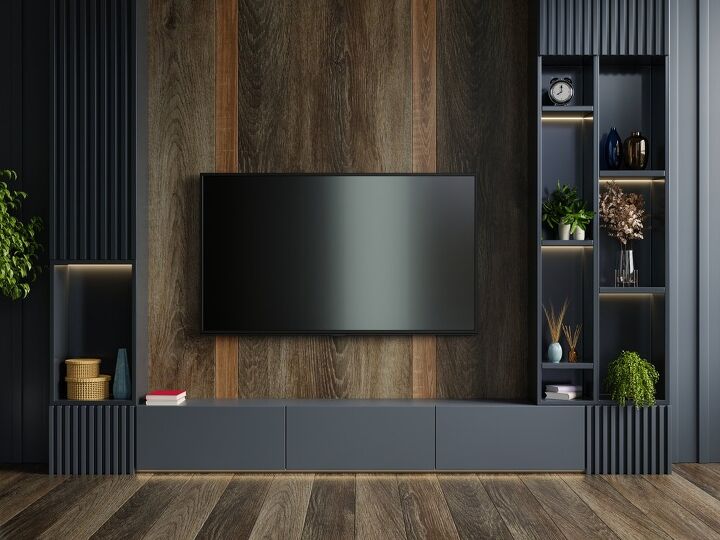Clever Tips And Tricks To Downplay Your TV

Do you ever wonder why you can’t recreate that gorgeous bedroom or living room that you see on Instagram? You try to achieve the same sophisticated ambiance in your space, but something isn’t right. Then it hits you. These designer pics are missing something that a lot of homes have front and center -- a giant black TV screen. Since you likely aren’t going to ditch your television, how can you downplay your TV to elevate your design?
A closed-door media cabinet is the simplest way to hide a television or use sliding doors or a wall-mounted TV cabinet. Fame out your TV, incorporate it into a gallery wall, or mount it on a floating media center. These choices help downplay the TV, so it doesn’t stand out as much. If you have a big budget, consider a mirror television or rolling projector screen.
Should you have a TV in your bedroom, living room, family room, or kitchen? It’s up to you to decide based on your personal preferences, habits, and where you like to watch television. But just because you decide to have a TV, doesn’t mean it needs to drag down your design.
Why Don’t Design Shows Include Televisions In The Final Design?
That big black box hanging on the wall always seems to be missing from magazine pictures, designer’s reels, and the final reveal on interior design shows. It’s not a mistake or oversight. Quite the contrary, it’s intentional.
From a practical standpoint, the TV screen often causes too many issues with reflections during filming. It’s easier to remove it than try to film around it, hoping it doesn’t pick up reflections of the crew or unwanted elements.
There are also aesthetic reasons. Often, the only time the TV gets a starring role in a design reveal is if the designer comes up with a clever way to disguise this popular electronic device. But more often, many designers, including those on HGTV, won’t put the TV back for the big reveal because it detracts from the overall design.
When the cameras stop rolling or the photo shoot ends, the TV ultimately goes back. After all, there’s the reality that many homeowners want to continue watching television and having movie nights.
Although, in some cases, the final look may make such an impact, the television doesn’t return. For example, you may fall so in love with a bedroom redesign sans TV that you decide to keep the room television-free. Besides looking better, a technology-free bedroom could earn you more relaxed sleep.
8 Ways To Integrate A TV Into Your Design
Good design is all about form and function. Therefore, if you want to watch TV in a space, then you need a TV in the room. But if you feel your television is taking away from your overall design, you might think you have no choice.
Luckily, that’s not the case. There are several ways to downplay a TV, so that it doesn’t take over your design.
1. Turn Your TV Into Art
Frame your TV and pull up a visual image to turn it into a piece of art. Various companies create custom frames for different television models. Choose a frame that complements the style of the room. Also, make sure the measurements are accurate so it sits snugly around the television.
2. Make Your TV Part Of A Gallery Wall
Another way to fool the eye and give the illusion that your television is a piece of art is to incorporate it into a gallery wall. Whether you choose to get a frame for the TV or not, grouping other artwork on the wall surrounding the TV can help. The added pieces help the TV fade into the background instead of standing out like a sore thumb.
3. Mount A Television Wall Cabinet
Television wall cabinets are designed to keep your TV out of sight when you don’t want to watch it. These cabinets mount to the wall and typically are backless so they fit around your TV. The doors on the front of the cabinet are usually a bifold style that folds out to the sides, out of the way of the screen.
Other styles provide an opportunity to add various pictures or artwork to the front. If you’re relatively handy, you could also construct a DIY unit.
4. Add Sliding Doors To Your TV Area
Do you have built-ins surrounding your TV, or do you mount your TV on a stand or in an open unit? If so, consider installing sliding doors in front. When you aren’t watching television, simply slide the doors in front of the screen.
If you have a smaller unit, one door may be all that you need. Imagine mounting a barn door that slides in front of your television. However, install the hardware on the back of the door instead of the front to create a seamless look.
5. Splurge On A Designer Television
You might not want to spring for a brand new TV if yours is in perfect working order. But if you’re ready to replace your existing television, or don’t mind the cost, consider a TV like Samsung’s The Frame. This television is designed to look like a framed piece of art on the wall.
You can even select from different frame options. When you aren’t watching TV, switch on “Art Mode” to enjoy a beautiful masterpiece that elevates your space.
6. Use A Closed-Door Media Cabinet
One of the easiest ways to hide a TV is to get a media cabinet with doors. Select one with cutouts for your cords and storage for your other electronic components. These pieces come in a variety of sizes, styles, and door options.
7. Is It A TV Or A Mirror?
Want to go really luxe and impress your friends? Is money no object? How about a more unconventional way to hide your TV in plain sight with something like MirrorVue? These products look like a mirror, but within the glass is a hidden screen that turns the mirror into a TV when in use.
Lots of commercial settings use these, including hotels and corporate offices. But they’re starting to appear with more frequency in residential settings. Typically, you’ll find smaller screens in a bathroom, etc., likely because the smaller the screen, the less expensive.
8. A Secret Screen
What about getting rid of the television altogether and replacing it with a projector screen? You could use a standard pull-down style or a screen on a stand. If you don’t watch television often, these flexible solutions may sound appealing.
But if you really want to impress, try a rollable secret screen. But be warned, these gadgets can cost well over $2,000, so it’s not a purchase you make on a whim.
Have Your TV And A Designer Look, Too
You don’t need to compromise your design integrity by resigning yourself to a big black box rectangle as the main focal point in your room. Even though you want a television in the space, it doesn’t mean it needs to be obvious.
Framing the TV to turn it into artwork or using a television like Samsung’s The Frame helps hide your TV in plain sight for minimal to average cost. For a more luxe (and expensive) solution, a TV mirror or rollable screen are other options.
But if you’re limited on funds, space, or time, downplay your TV by drawing more attention to its surroundings. Incorporate the television into a gallery wall or mount it on a gorgeous floating media cabinet. Doing this means you avoid a solid black blob floating solo on your wall. A closed-door cabinet, sliding doors, or wall-mounted cabinets are other simple ways to hide your TV when not in use.
Decide which solution makes the most sense for you, based on your available space and budget. Then it’s time to start enjoying your TV, instead of thinking of it as an eyesore.
Related Guides:

Stacy Randall is a wife, mother, and freelance writer from NOLA that has always had a love for DIY projects, home organization, and making spaces beautiful. Together with her husband, she has been spending the last several years lovingly renovating her grandparent's former home, making it their own and learning a lot about life along the way.
More by Stacy Randall
















![Cost To Drill A Well [Pricing Per Foot & Cost By State]](https://cdn-fastly.upgradedhome.com/media/2023/07/31/9074980/cost-to-drill-a-well-pricing-per-foot-cost-by-state.jpg?size=350x220)
![Standard Dining Room Table Dimensions [for 4, 6, 8, 10 and 12 People]](https://cdn-fastly.upgradedhome.com/media/2023/07/31/9074335/standard-dining-room-table-dimensions-for-4-6-8-10-and-12-people.jpg?size=350x220)









